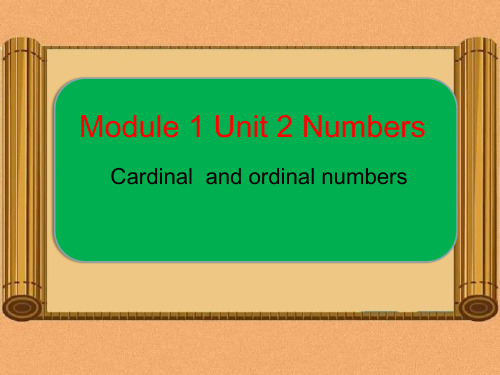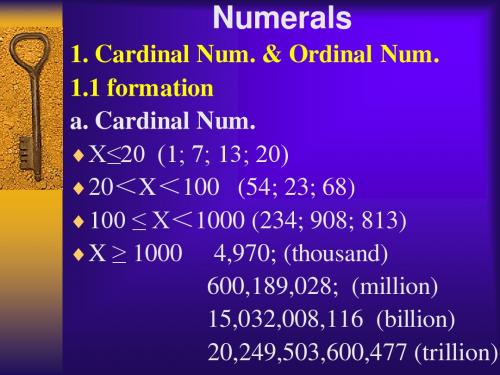美英国小学教材资料cardinal-and-ordinal-numbers
- 格式:pdf
- 大小:859.38 KB
- 文档页数:11

1英语基数词和序数词English is a language that utilizes two distinct types of numerical systems known as cardinal numbers and ordinal numbers. Cardinal numbers represent the quantity of objects, while ordinal numbers indicate the position or order of objects. Understanding the proper usage and application of these numerical systems is crucial for effective communication and comprehension in the English language.Cardinal numbers, also referred to as "counting numbers," are used to express the quantity or amount of something. They start with the number one and continue in a sequential order, with each subsequent number representing one more than the previous. The cardinal numbers in English are: one, two, three, four, five, six, seven, eight, nine, ten, eleven, twelve, and so on. These numbers can be used to quantify nouns, such as "I have five apples" or "There are twenty-three people in the room."Ordinal numbers, on the other hand, are used to indicate the position or order of objects within a sequence. They are derived from the cardinal numbers by adding the suffix "-th" to the end of thenumber, with the exception of the first three ordinal numbers: first, second, and third. The ordinal numbers in English are: first, second, third, fourth, fifth, sixth, seventh, eighth, ninth, tenth, eleventh, twelfth, and so on. Ordinal numbers are commonly used to describe the position of an item in a list or sequence, such as "She finished in third place" or "The first house on the street is blue."It is important to note that the usage of cardinal and ordinal numbers can vary depending on the context and the specific grammatical structure of the sentence. For example, when used as adjectives, cardinal numbers typically precede the noun they modify, as in "I have three apples." Ordinal numbers, on the other hand, are usually placed before the noun they modify, as in "She is the fifth person in line."Additionally, the formation of ordinal numbers can sometimes be irregular, particularly for the numbers ending in "-one," "-two," and "-three." For instance, the ordinal number for "one" is "first," not "oneth," and the ordinal number for "two" is "second," not "twoth." These irregularities can be challenging for non-native English speakers to remember, but understanding them is crucial for accurate communication.Another important aspect of cardinal and ordinal numbers in English is their use in dates, times, and other numerical expressions. Forexample, when expressing a date, the day of the month is typically an ordinal number, such as "the 5th of May" or "the 22nd of December." When expressing time, cardinal numbers are used to indicate the hour, while ordinal numbers are used to indicate the minute, as in "it is ten thirty-five" or "the meeting starts at three forty-five."Furthermore, cardinal and ordinal numbers can be combined in various ways to convey more complex numerical information. For instance, a person's age is typically expressed using a cardinal number, as in "She is twenty-five years old." However, when referring to a person's birthday, the day of the month is expressed using an ordinal number, as in "Her birthday is on the 15th of June."In conclusion, the proper understanding and application of cardinal and ordinal numbers are essential for effective communication in the English language. These numerical systems are used in a wide range of contexts, from basic quantification to more complex expressions of time, date, and age. By mastering the usage of these numerical systems, individuals can improve their overall proficiency in English and enhance their ability to communicate effectively in a variety of situations.。


英语数字基数词序数词The English language is known for its rich and diverse vocabulary, and one aspect of this is the use of numbers. In English, we have two main types of numbers: cardinal numbers and ordinal numbers. Cardinal numbers are the basic counting numbers, such as one, two, three, and so on, while ordinal numbers are used to indicate position or order, such as first, second, third, and so on. Understanding the differences and proper usage of these two types of numbers is important for effective communication in English.Cardinal numbers are the most fundamental and commonly used numbers in the English language. They are used to represent quantity and are the numbers we typically use for counting, measuring, and quantifying things. Cardinal numbers start with the number one and continue in a sequence, with each number being one more than the previous number. For example, one, two, three, four, five, and so on. These numbers can be used in a variety of contexts, such as when stating the number of people in a room, the amount of money in a bank account, or the number of days in a week.One interesting aspect of cardinal numbers in English is the way they are formed. The numbers from one to ten are all unique words, such as one, two, three, four, and so on. However, for numbers greater than ten, the formation of the words becomes more complex. For example, the number eleven is formed by combining the word "ten" with the word "one," resulting in "eleven." Similarly, the number twelve is formed by combining "ten" and "two," resulting in "twelve." This pattern continues for the numbers up to nineteen, with each number being a unique word that combines "ten" with the corresponding number from one to nine.For numbers greater than nineteen, the formation of cardinal numbers becomes even more complex. These numbers are formed by combining the words for the tens (twenty, thirty, forty, and so on) with the words for the ones (one, two, three, and so on). For example, the number twenty-three is formed by combining the word "twenty" with the word "three." This pattern continues for all the numbers up to one hundred, and then the process repeats for the hundreds, thousands, and so on.Ordinal numbers, on the other hand, are used to indicate position or order. They are used to describe the position of something in a sequence, such as first, second, third, and so on. Ordinal numbers are typically formed by adding the suffix "-th" to the end of thecorresponding cardinal number, with some exceptions. For example, the ordinal number for the cardinal number one is "first," the ordinal number for the cardinal number two is "second," and the ordinal number for the cardinal number three is "third."There are a few exceptions to this rule, however. For example, the ordinal numbers for the numbers one, two, and three are "first," "second," and "third," respectively, rather than "oneth," "twoth," and "threeth." Additionally, the ordinal numbers for the numbers eleven and twelve are "eleventh" and "twelfth," rather than "eleventh" and "twelveth."Another interesting aspect of ordinal numbers in English is the way they are used in dates and other contexts. For example, when referring to a specific day of the month, we typically use ordinal numbers, such as "the first of January" or "the fifteenth of March." Similarly, when referring to a person's position in a sequence, such as in a race or a competition, we use ordinal numbers, such as "first place" or "third place."In addition to their use in dates and competitions, ordinal numbers can also be used in other contexts, such as when describing the position of something in a list or sequence. For example, we might say "the fourth item on the list" or "the tenth chapter in the book."Overall, the use of cardinal and ordinal numbers in English is an important aspect of the language that requires careful attention and practice. Understanding the differences between these two types of numbers and how to use them correctly is essential for effective communication in a wide range of contexts, from everyday conversations to academic and professional settings.。


数字词汇:认识数字的英文表达Numbers Vocabulary: Understanding English Expressions for NumbersIntroduction:Numbers are an integral part of our daily lives, serving as a means of communicating quantities, measurements, and various forms of data. In this article, we will explore the English expressions used to represent numbers. By acquainting ourselves with these expressions, we can enhance our language skills and effectively communicate numerical information in English.Cardinal Numbers:Cardinal numbers are used to denote quantity or counting. They are the basic numbers used in everyday conversations. Here are a few essential English expressions for cardinal numbers:1. One:As the first cardinal number, 'one' represents singularity or unity. It is often associated with uniqueness and independence. For instance, "There is only one sun in our solar system."2. Two:'Two' signifies duality or a pair. It is frequently used when referring to a couple or a binary situation. For example, "We divided into two teams for the competition."3. Three:'Three' often symbolizes completion or perfection. It is connected with concepts like the Trinity or the three primary colors. A popular expression is "Third time's the charm," highlighting the idea of success after multiple attempts.4. Four:'Four' is a number that represents stability or solidity. It is connected to the four directions (north, south, east, and west) and the four seasons. For instance, "The table has four legs, ensuring stability."Ordinal Numbers:Ordinal numbers are used to indicate the position or order of something. They add a sense of sequence or hierarchy to numerical information. Let's explore the English expressions for ordinal numbers:1. First:'First' denotes being in the initial position or coming before all others. It often signifies achievement or priority. For example, "She won first place in the race."2. Second:'Second' represents being next in line or following the first. It is commonly used in competitions or rankings. A well-known phrase is "The early bird catches the worm, but the second mouse gets the cheese."3. Third:'Third' refers to coming after the first and second. It can suggest the final step in a process or hierarchy. For instance, "He completed the first and second parts of the project; now he's on the third."4. Fourth:'Fourth' implies being in the position after the third. It is often associated with the final phase of a series or a competition. An example sentence is: "In the fourth quarter, our team made a comeback and won the game."Fractions and Decimals:In addition to whole numbers, fractions and decimals play a crucial role in expressing numerical values. Here are some common English expressions related to fractions and decimals:1. Half:'Half' represents a division into two equal parts. It is often used when dividing or sharing something. For example, "She gave half of her sandwich to her friend."2. Quarter:'Quarter' refers to a division into four equal parts. It is commonly used when expressing time or financial values. A typical expression is: "The meeting will start at a quarter past nine."3. Decimal:Decimals are fractional numbers expressed using a decimal point. They are frequently used in mathematical calculations or when representingprecise measurements. For instance, "The temperature rose by 0.5 degrees Celsius."Conclusion:Understanding and utilizing the English expressions for numbers is essential for effective communication in various contexts, including daily conversations, academic settings, or professional environments. By familiarizing ourselves with cardinal and ordinal numbers, as well as fractions and decimals, we can confidently express numerical information in English. Remember, mastering numbers vocabulary opens the door to clear and accurate communication in any language. As Albert Einstein once said, "Do not worry about your difficulties in mathematics. I can assure you mine are still greater."。

19世纪伟大数学家高斯(Gauss,1777-1855年)曾说:"研究欧拉的著作永远是了解数学的最好方法."1.数论欧拉的一系列成奠定作为数学中一个独立分支的数论的基础。
欧拉的著作有很大一部分同数的可除性理论有关。
欧拉在数论中最重要的发现是二次反律。
2.代数欧拉《代数学入门》一书,是16世纪中期开始发展的代数学的一个系统总结。
3.无穷级数欧拉的《微分学原理》(Introductio calculi differentialis,1755)是有限差演算的第一部论著,他第一个引进差分算子。
欧拉在大量地应用幂级数时,还引进了新的极其重要的傅里叶三角级数类。
1777年,为了把一个给定函数展成在(0,“180”)区间上的余弦级数,欧拉又推出了傅里叶系数公式。
欧拉还把函数展开式引入无穷乘积以及求初等分式的和,这些成果在后来的解析函数一般理论中占有重要的地位。
他对级数的和这一概念提出了新的更广泛的定义。
他还提出了两种求和法。
这些丰富的思想,对19世纪末,20世纪初发散级数理论中的两个主题,即渐近级数理论和可和性的概念产生了深远影响。
4.函数概念18世纪中叶,分析学领域有许多新的发现,其中不少是欧拉自已的工作。
它们系统地概括在欧拉的《无穷分析引论》、《微分学原理》和《积分学原理》组成的分析学三部曲中。
这三部书是分析学发展的里程碑四式的著作。
5.初等函数《无穷分析引论》第一卷共18章,主要研究初等函数论。
其中,第八章研究圆函数,第一次阐述了三角函数的解析理论,并且给出了棣莫佛(de Moivre)公式的一个推导。
欧拉在《无穷分析引论》中研究了指数函数和对数函数,他给出著名的表达式(这里i表示趋向无穷大的数;1777年后,欧拉用i表示),但仅考虑了正自变量的对数函数。
1751年,欧拉发表了完备的复数理论。
6.单复变函数通过对初等函数的研究,达朗贝尔和欧拉在1747-1751年间先后得到了(用现代数语表达的)复数域关于代数运算和超越运算封闭的结论。